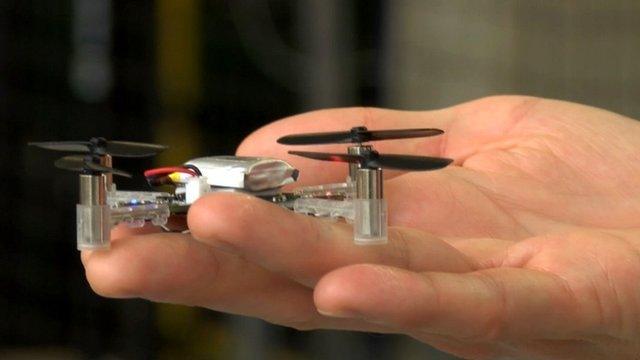Robo-bee: miniature robot perches like an insect
- Published
Miniature flying robot that can perch and take off could be used in search and rescue, scientists say
Scientists have designed flying, insect-sized robots that can perch and launch from ceilings.
The robots use something called electrostatic adhesion, the same process by which statically-charged balloons stick to walls.
Perching allows the robots to conserve energy.
The findings, reported in the journal Science, external, contribute to a decade-long Harvard Microrobotics Laboratory, external project called "RoboBee".
The robots in this study are programmed drones, each around the size of a 10 pence coin.
Dr Mirko Kovac, director of the Aerial Robotics Laboratory of Imperial College, London, external, who was not involved in this study, told BBC News that similar robots were currently being trialled in environmental monitoring and disaster-relief efforts.
Dr Kovac, who develops flying robots in his own lab, wrote a paper in the same issue of Science explaining how nature had inspired the design of RoboBee and other robotic perching mechanisms, external.
Equipped with sensors, swarms of such small, relatively cheap robots, Dr Kovac explained, could alert first responders to the most intense areas of forest fires or other natural disasters.
Energy-saving perch
Moritz Graule, a PhD student at the Massachusetts Institute of Technology and lead researcher on the project said: "Hovering microrobots run out of energy really quickly." Perching, he said, provides a solution to that problem.
But mechanical perching tools, like birds' claws, are too cumbersome for such small robots. Detaching easily from a surface was another challenge; if perching was the only goal, Mr Graule said, "we could have put a little glue on top of the robot".
To solve these problems, the researchers designed a small, flat "landing patch" with an electrostatic charge that can be switched on and off.
When switched on, the patch acquires a negative charge that makes it stick to nearby, more positively charged surfaces.
You can experience a similar effect by "rubbing a balloon on your hair then sticking it to a wall," explained principal investigator of the Harvard RoboBee project, Dr Robert Wood. And for the dismount, said Dr Wood, "[we] simply remove power to the patch".
What the team is most excited about though are the opportunities that such minuscule component parts promise for other applications. For these robots, "nothing exists off the shelf," said Dr Wood. "We have to reinvent for these systems."
That reinvention opens up new frontiers for very tiny devices - from manufacturing to micro-surgery.
Dr Mirko Kovac from Imperial College explains how drones whose design is inspired by nature are set to become part of our everyday lives
- Published23 May 2014
